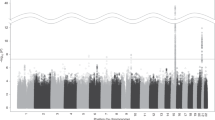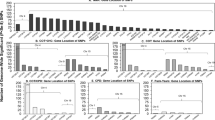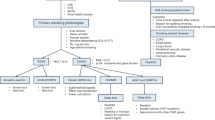Abstract
Twin studies indicate that additive genetic effects explain most of the variance in nicotine dependence (ND), a construct emphasizing habitual heavy smoking despite adverse consequences, tolerance and withdrawal. To detect ND alleles, we assessed cigarettes per day (CPD) regularly smoked, in two European populations via whole genome association techniques. In these ∼7500 persons, a common haplotype in the CHRNA3–CHRNA5 nicotinic receptor subunit gene cluster was associated with CPD (nominal P=6.9 × 10−5). In a third set of European populations (n=∼7500) which had been genotyped for ∼6000 SNPs in ∼2000 genes, an allele in the same haplotype was associated with CPD (nominal P=2.6 × 10−6). These results (in three independent populations of European origin, totaling ∼15 000 individuals) suggest that a common haplotype in the CHRNA5/CHRNA3 gene cluster on chromosome 15 contains alleles, which predispose to ND.
This is a preview of subscription content, access via your institution
Access options
Subscribe to this journal
Receive 12 print issues and online access
$259.00 per year
only $21.58 per issue
Buy this article
- Purchase on Springer Link
- Instant access to full article PDF
Prices may be subject to local taxes which are calculated during checkout


Similar content being viewed by others
References
World Health Organization. World Health Statistics 2006. WHO Press: New York, NY, 2006; http://www.who.int/whosis.
Sullivan PF, Kendler KS . The genetic epidemiology of smoking. Nicotine Tob Res 1999; 1: S51–S57.
Lessov CN, Martin NG, Statham DJ, Todorov AA, Slutske WS, Bucholz KK et al. Defining nicotine dependence for genetic research: evidence from Australian twins. Psychol Med 2004; 34: 865–879.
Lessov-Schlaggar CN, Pang Z, Swan GE, Guo Q, Wang S, Cao W et al. Heritability of cigarette smoking and alcohol use in Chinese male twins: the Qingdao twin registry. Int J Epidemiol 2006; 35: 1278–1285.
Maes HH, Sullivan PF, Bulik CM, Neale MC, Prescott CA, Eaves LJ et al. A twin study of genetic and environmental influences on tobacco initiation, regular tobacco use and nicotine dependence. Psychol Med 2004; 34: 1251–1261.
Li MD . The genetics of nicotine dependence. Curr Psychiatry Rep 2006; 8: 158–164.
Bierut LJ, Madden PA, Breslau N, Johnson EO, Hatsukami D, Pomerleau OF et al. Novel genes identified in a high-density genome wide association study for nicotine dependence. Hum Mol Genet 2007; 16: 24–35.
Saccone SF, Hinrichs AL, Saccone NL, Chase GA, Konvicka K, Madden PA et al. Cholinergic nicotinic receptor genes implicated in a nicotine dependence association study targeting 348 candidate genes with 3713 SNPs. Hum Mol Genet 2007; 16: 36–49.
Heatherton TF, Kozlowski LT, Frecker RC, Fagerström KO . The Fagerström test for nicotine dependence: a revision of the Fagerström tolerance questionnaire. Br J Addict 1991; 86: 1119–1127.
Beuten J, Ma JZ, Payne TJ, Dupont RT, Crews KM, Somes G . Single- and multilocus allelic variants within the GABA(B) receptor subunit 2 (GABAB2) gene are significantly associated with nicotine dependence. Am J Hum Genet 2005; 76: 859–864.
Grant BF, Kaplan K, Shepard J, Moore T . Source and Accuracy Statement for Wave 1 of the 2001–2002. National Epidemiological Survey on Alcohol and Related Conditions. National Institute on Alcohol Abuse and Alcoholism: Bethesda, MD, 2003.
CDC. Annual smoking-attributable mortality, years of potential life lost, and productivity losses-United States. Morbidity & Mortality Weekly Report 2005; 54: 625–628.
Purcell S, Neale B, Todd-Brown K, Thomas L, Ferreira MA, Bender D et al. PLINK: a tool set for whole-genome association and population-based linkage analyses. Am J Hum Genet 2007; 81: 559–575.
Roses A, Burns D, Chissoe S, Middleton L, St Jean P . Disease-specific target selection: a critical first step down the right road. Drug Disc Today 2005; 10: 177–186.
Marchini J, Howie B, Myers S, McVean G, Donnelly P . A new multipoint method for genome-wide association studies by imputation of genotypes. Nat Genet 2007; 39: 906–913.
Soldà G, Boi S, Duga S, Fornasari D, Benfante R, Malcovati M et al. In vivo RNA-RNA duplexes from human alpha3 and alpha5 nicotinic receptor subunit mRNAs. Gene 2005; 345: 155–164.
Gotti C, Moretti M, Gaimarri A, Zanardi A, Clementi F, Zoli M . Heterogeneity and complexity of native brain nicotinic receptors. Biochem Pharmacol 2007; 74: 1102–1111.
Gerzanich V, Wang F, Kuryatov A, Lindstrom J . A5 subunit alters desensitization, pharmacology, Ca++ permeability and Ca++ modulation of human neuronal A3 nicotinic receptors. J Pharmacol Exp Ther 1998; 266: 311–320.
Acknowledgements
We thank Sreekumar Pillai, for helpful discussions. Allen Roses, Lefkos Midleton, Perry Nisen, Paul Matthews and Emilangelo Ratti are thanked for their support of these genetic studies. We are indebted to the GEMS/Lausanne investigators, including Antero Kesaniemi, Gerard Waeber, Phil Barter, Bob Mahley, Ruth McPherson, Scott Grundy and Tom Bersot. Supplementary information is available at the Molecular Psychiatry website. WHB was supported by NIDA Grant P60 05186 to Charles O'Brien, MD, PhD, by a grant from the Tzedekah Foundation, by the Veterans Administration VISN4 Mental Illness Research, Education and Clinical Center (David Oslin, MD, PI, USA) and by a grant from Philip and Marcia Cohen.
Author information
Authors and Affiliations
Corresponding author
Additional information
Supplementary Information accompanies the paper on the Molecular Psychiatry website (http://www.nature.com/mp)
Supplementary information
Rights and permissions
About this article
Cite this article
Berrettini, W., Yuan, X., Tozzi, F. et al. α-5/α-3 nicotinic receptor subunit alleles increase risk for heavy smoking. Mol Psychiatry 13, 368–373 (2008). https://doi.org/10.1038/sj.mp.4002154
Received:
Accepted:
Published:
Issue Date:
DOI: https://doi.org/10.1038/sj.mp.4002154
Keywords
This article is cited by
-
Tobacco and nicotine use
Nature Reviews Disease Primers (2022)
-
Nicotinic acetylcholine gene cluster CHRNA5-A3-B4 variants influence smoking status in a Bangladeshi population
Pharmacological Reports (2021)
-
Cocaine potently blocks neuronal α3β4 nicotinic acetylcholine receptors in SH-SY5Y cells
Acta Pharmacologica Sinica (2020)
-
CHRNA5/CHRNA3 gene cluster is a risk factor for lumbar disc herniation: a case-control study
Journal of Orthopaedic Surgery and Research (2019)
-
GWAS of smoking behaviour in 165,436 Japanese people reveals seven new loci and shared genetic architecture
Nature Human Behaviour (2019)



